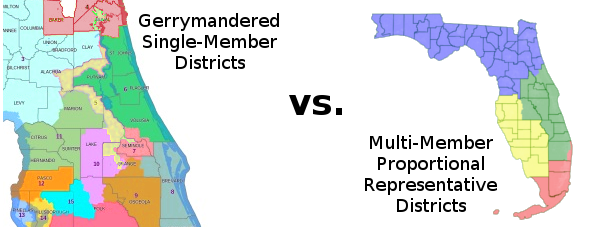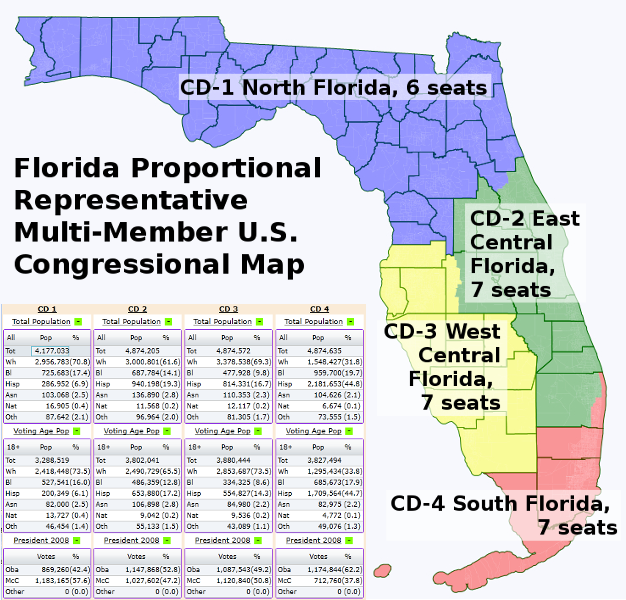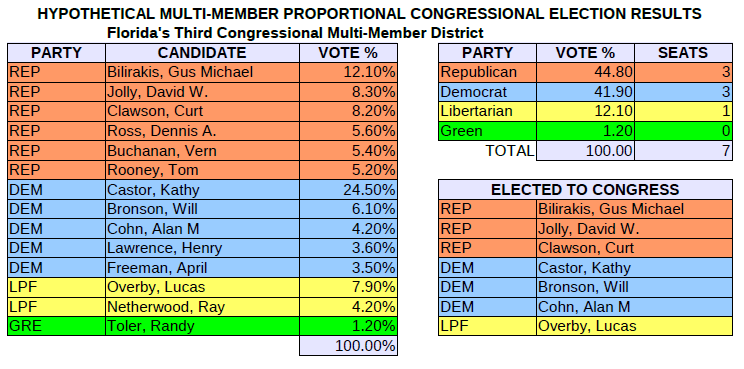

|
By Matt Florell 2014-06-23
The recent redistricting trial and the testimony that has come out of it shows some of the problems with the current redistricting and gerrymandering processes that we have here in Florida. Our single-member congressional districts, where the candidate with the most votes wins, often leaves significant numbers of voters without a representative that shares their political views. Also, those elected Representatives' views almost always come from only the two major political parties, with almost no possibility for third parties to have a realistic chance of winning. In a congressional race with more than two candidates, it is the majority of the voters who are often left supporting a losing candidate. This method of electing our representatives is actually not the method that most other representative democracies in the world use. One of the more popular methods that other countries use to elect their legislative leaders is through a process called Proportional Representation. Proportional Representation(PR) uses multi-member districts to elect several representatives in one geographic area from multiple political parties, with the share of representatives from each party being roughly the same percentage as the votes received by each party. With PR, there is less capacity for "safe seats" like we see in many Florida Congressional districts. Also, unchallenged elections would be almost unheard of under Proportional Representation. In 2014, four of the 27 Congressional seats up for election in Florida will not be voted on because only the incumbent filed to run and they automatically won without a public vote. I decided to try to see what a map would look like in Florida if we used Proportional Representation. In order to keep some geographic segmentation as well as a lower vote share threshold per seat, I divided Florida's 27 Congressional seats into four different multi-member districts, mostly based upon county borders. The least densely populated district would have six seats while the other three districts would have seven seats. There is a great, free district mapping tool called Dave's Redistricting It uses the 2010 census data and allows you to easily draw your own districts down to the precinct level in Florida and many other states. You can download the mapping file I created here and load it into the Dave's Redistricting web application if you want to see for yourself what it looks like. I kept the population in each of the districts proportional to the number of seats they would have assigned to them. I also tried to keep the major cities and city groups together as well(You can click on the map below to see a population density map). The first district is North Florida, which is everything North of Orlando and the Tampa Bay area. The second district includes the Orlando area and down the East coast into most of Palm Beach County. The third district is the Tampa Bay area and down the West coast including Collier County. The forth district is the Miami area from southern Palm Beach County down to Key West. This map keeps all but three counties entirely within the boundaries of a single district and is very technically compact for a district map. 
(click on the map above to see a higher resolution population density district map) Florida Congressional Elections Using 4 Multi-Member Proportional Representation Districts - CD-1: North Florida, 6 congressional districts, 4.18 million people - based upon 2008 voting(42.4%/57.6%), 3 DEM and 3 REP CD-2: East Central Florida, 7 congressional districts, 4.87 million people - based upon 2008 voting(52.8%/47.2%), 4 DEM and 3 REP CD-3: West Central Florida, 7 congressional districts, 4.87 million people - based upon 2008 voting(49.2%/50.8%), 3 DEM and 4 REP CD-4: South Florida, 7 congressional districts, 4.87 million people - based upon 2008 voting(62.2%/37.8%), 4 DEM and 3 REP Hypothetical Florida Congressional Delegation by Party using 2008 voting party preference and Multi-member maps: 14 Democrats 13 Republicans Real Florida Congressional Delegation by Party after 2012 election: 10 Democrats 17 Republicans How exactly would voting work? Voting would be a lot like it is now, except that your vote for a candidate would also be a vote for a party, and there would be a lot more candidates on the ballot. Each party would be able to put as many candidates on the ballot as there are seats in the district, and if a candidate receives a full share of votes in their district, they would automatically win a seat. A full share for the example map above would be 16.67% in District 1 and 14.29% in the other three districts. Any remaining seats would be allocated based upon the next largest share of the votes per party, and the next-highest vote totals for a candidate within the party. In Proportional Representative elections, the issue of minority representation is handled without the need for extreme Gerrymandering like we see in Florida's current fifth Congressional district. In every one of the four proposed districts, the minority voter percentage is greater than the minimum threshold to guarantee a seat, which ensures that even small minority voting interests can have a significant impact on elections. This type of election is also more responsive to changing voter preferences. In all cases, if there is at least a 14-17% party vote shift from one election to the next, then a seat will shift from one party to another. In most cases the shift could be much smaller. In my example map above, within district 1, if there is only a 1% shift from Democratic to Republican votes, the representative split would go from 3-D/3-R to 2-D/4-R. This also allows for third parties, like the Green party or Libertarian party, to more easily win a seat in an election. StPetePolls.org conducted a telephone poll of 729 Pinellas County voters on June 4th 2014 that asked "If you could vote to be represented by any political party, even if you are not a member of that party right now, which one would it be?". The Republican and Democratic parties combined received about 70% of the vote, with third parties or No Party Affiliation receiving 30%. This shows that there is a large segment of voters that are not currently being represented by their first choice of a political party. Under a Proportional Representative system, it would be much easier for those third party voters to be represented by their first party choice. Below is an example of a hypothetical set of election results for what would be the 3rd multi-member proportional representative Congressional district of Florida. The candidate names were taken from recent ballots in what would be that geographic area(The Tampa Bay area South including Collier County). This example shows how the Congressional seats would be distributed in a proportional representative multi-member election system given the included election results. 
Can we really change to Proportional Representative Voting here in Florida? The answer is, not easily. The two major political parties would lose influence under this kind of election system, as well as many long serving representatives losing their safe seats. The chances of the Republicans and Democrats agreeing to this are somewhere between slim and none. But, we used to have multi-member districts at the state level, although they were not used in the way I am proposing as proportional representation. They were all at-large seats that were used partly to prevent minority representatives from being elected. That method was discontinued in 1982 in favor of single-member districts under pressure from minority groups and the Republican party. There is a state Constitution Revision Commission coming up in 2017, and Florida has changed it's voting methods before, so it could happen. At the federal level, multi-member districts are not prohibited by the U.S. Constitution, they are only prohibited by one provision of a 1967 law (PL 90-196) that prevented at-large and multi-member district elections in states with more than one U.S. Representative. For Florida to use Multi-Member Proportional Representative elections for Congressional seats, it would require an act of Congress to reverse that provision of the 1967 law. At the state level, there is nothing specific in the state Constitution preventing Florida from using this election method for Congressional seats. The only possible issue is a mention that congressional districts should be as "equal in population as practicable", but a change in the federal law could override that clause. If it does not, then it would be possible to create three equal population districts with nine seats each. One step we could take here in Florida to try out this method of elections is to move our state House to PR multi-member districts, but that change has several other hurdles in front of it, so its a subject for another day. Hopefully, one result of the redistricting trial will be a serious discussion about reforming our elections process to better avoid the pitfalls of our current system and enable us to have a government that more accurately represents the view of the voters. I think that Proportional Representation could help us do both. For more background information on Open Ballot Proportional Representation, take a look at these websites: - Mount Holyoke College Proportional Representation Library - Wikipedia entry for Proportional Representation - Proportional-Representation.org |


